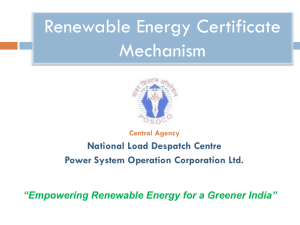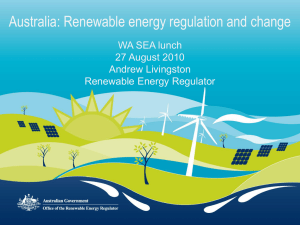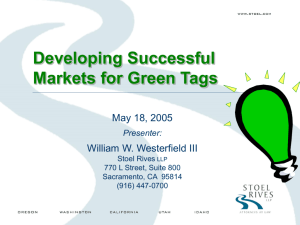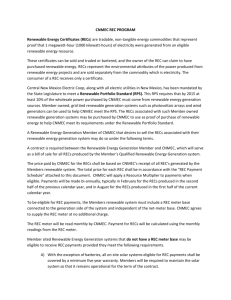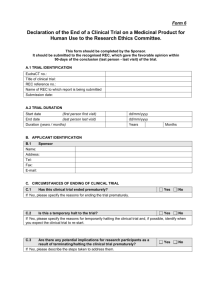PacifiCorp Time of Use Presentation
advertisement
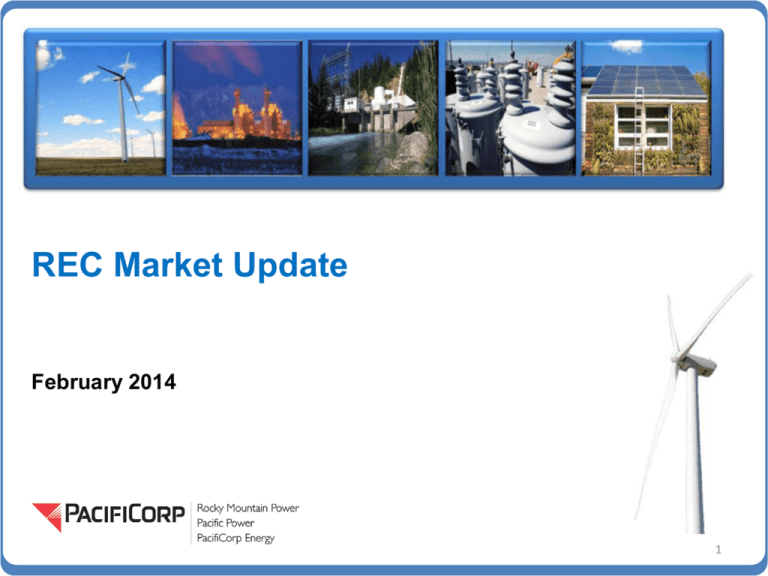
REC Market Update February 2014 1 REC Market Characteristics • Renewable energy markets are driven by either state-imposed mandates for use of renewable energy resources (Compliance Market) or voluntary initiatives to offset electricity use with the green attributes of renewable energy (Voluntary Market). • The various state REC markets present an opportunity for regulated electricity providers, renewable energy developers, and marketers to meet regulatory requirements, hedge price risk, and generate additional revenue from renewable energy projects. – – • Compliance Markets account for a majority of trading in renewable energy certificates (RECs). Voluntary Markets represent an opportunity for market participants to monetize the environmental benefits from the renewable projects to reduce net power cost. The REC market, in both compliance and voluntary markets, is comprised of past or current vintage (period in which the REC is produced), and forward vintage. Prices can differ substantially between past vintage and forward vintage. Forward vintage REC pricing often lacks transparency and consistent depth (the volume being offered can fluctuate at any point in time and sometimes not exist). 2 Compliance REC Market • • • • • Compliance Markets are created when a state passes a Renewable Portfolio Standard (RPS). States with RPS require that retail power suppliers obtain a set percentage of the electricity they sell from renewable sources. Many states across the country have enacted some form of renewable portfolio standards. A state's RPS will list the types of sources of renewable energy that are eligible, and may also create different classes of renewable energy. It may also distinguish between "new" and "existing" facilities. The corresponding RPS legislation typically contains an implementation schedule that increases the required percentage each year. Typically, states that permit REC trading for compliance with an RPS also provide a tracking system enabling renewable developers to register RECs as they are generated and track their eventual sale in the market (In the West, this is WREGIS). The most salient feature of the compliance markets is that they differ considerably from state to state. As a result, prices may differ. Compliance buyers are generally indifferent to the type of resource that created the REC, as long as it qualifies and is tied to a specific qualifying geographic region from where the REC can be sourced. Therefore, price drivers in each compliance market evolve around the rules dictating trading under the RPS, including what qualifies as a renewable resource, rules on interconnection, existing renewable energy supply in the state, and electricity demand. 3 CA RPS MARKET OVERVIEW Source: PG&E Renewable Portfolio Standard Policies.. www.dsireusa.org / March 2013. 29 states,+ Washington DC and 2 territories,have Renewable Portfolio Standards (8 states and 2 territories have renewable portfolio goals). Voluntary REC Market • Many companies, government agencies, and private consumers have opted to support "green power“ either by buying renewable energy direct or through a variety of retail programs. Buying direct or supporting new construction is weighed against purchasing the RECs from existing renewable projects, providing the same benefit in a cost-effective way, while minimizing retail program rate adjustments. In many cases, buyers are purchasing the RECs associated with renewable energy generation. • Voluntary market purchases are usually for unbundled RECs, and rely on certification programs that verify that the RECs were generated by the type of renewable source that is claimed, and that a REC is not sold to more than one buyer. • Voluntary programs are driven by environmental disclosure, consumer demand, and corporate commitments. Voluntary buyers are usually more concerned with resource type than with geographic location. Compliance prices are generally higher than voluntary prices. • Renewable energy project developers with projects outside of the jurisdiction of a state RPS program may find an opportunity to generate additional revenue through the sale of RECs into the voluntary market. 6 Transacting in REC Market • • • • • • • REC transactions are typically negotiated bilaterally between counterparties. While several REC market brokers attempt to capture both voluntary and compliance markets they typically only facilitate transactions in the voluntary market where the transaction terms usually standard, but they occasionally participate in the non-standard, compliance markets. Brokers typically only match buyers to sellers, and are not a principal counterparty in transactions. A centralized, transparent online trading platform for REC transactions currently does not exist. Issuing requests for proposals to the market has shown to be an effective method of meeting REC transacting needs of market participants, obtaining price discovery and obtaining competitive pricing. PacifiCorp participates in requests for proposals from the market, issues reverse request for proposals to the market, and completes bilateral transactions. Brokers are rarely quoting prices currently beyond 2016. Pricing can range between $1.00 and $16.50 depending on the structure and term of the transaction. 7 Current REC Market Drivers Current fundamental drivers affecting the REC market depth and price volatility: • Market REC sale opportunities continue to be limited in California RPS market due to: 1. Market preference for long-term power purchase agreements (over 10 years) and acquisition or build of in-state renewable resources 2. Most California compliance entities having already met Compliance Period 2 (2014 – 2016) requirements and no longer need current year vintage RECs. • Requirements and product definitions to meet the California RPS compliance requirements favor utility purchase of in-state renewable resources and have limited the Company’s opportunities to sell RECs in the California market. • The REC market in the WECC for meeting compliance requirements in states other than California continues to show limited demand, is nontransparent and illiquid. 8 Blue Sky RECs vs. WECC RECs Blue Sky Product Definition Greatly Limits the Pool of Eligible Facilities 9 Market Dynamics • Product determines the price range. In general, the more constrained the criteria and less the supply, the higher the price. Already in 2014, WECC RECs have traded below $1.00 and over $16.50/MWh, with narrowly defined products trading well above this level. • Contract term impacts pricing: Purchasing future vintages costs more than current vintages of the same product. This is primarily driven by uncertainty about voluntary and compliance market fundamentals in future years. Depending on the term and other market factors, a multi-year agreement could dramatically increase price above short-term prices. However, long-term agreements greatly reduce supply risk. • Contract structure affects price: Individual contract details including volume, a firm vs. unit contingent delivery obligation, delivery timing, marketing rights, etc. dictate the obligations and risk profile of both parties and impact the REC cost. 10 Portfolio Management • Program Level: – – – – Variable Demand: New customer enrollment, attrition and annual program REC sales vary widely over time. This uncertainty requires a procurement strategy that accounts for and mitigates the risks associated with the constantly changing needs. Price Stability: Products are priced at a level that are expected to be stable over the term of the agreement which insulates the customer from volatile market price changes. Product Content Label (PCL): Each year a Prospective PCL is published which defines the product mix and greatly limits supply flexibility for the upcoming year. Regulatory Change: While uncommon in compliance markets, virtually all Green-e transactions place the regulatory continuing commitment on the REC seller which increases the all-in cost of the RECs while reducing the portfolio risk profile. • Contract Level: – – Unit Contingent vs. Firm: Unit contingent REC purchases specify delivery of XX% of the facility output over a specified time period instead of a firm quantity. As such, the actual quantity of purchased RECs varies from the quantity specified in the contract due to performance of the facility. All else equal, firm REC transactions tend to be more expensive than unit contingent transactions since the seller bears the facility performance risk. Project and Operational Risk: Rules, regulations and standards change over time and can impact a facilities ability to perform. A portfolio of projects diversifies this risk across different geographies, technologies, etc. 11
